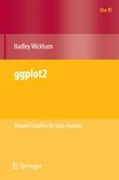
This book describes ggplot2, a new data visualization package for R that usesthe insights from Leland Wilkison’s Grammar of Graphics to create a powerful and flexible system for creating data graphics. With ggplot2, it’s easy to: produce handsome, publication-quality plots, with automatic legends created fromthe plot specification, superpose multiple layers (points, lines, maps, tiles, box plots to name a few) from different data sources, with automatically adjusted common scales, add customisable smoothers that use the powerful modelling capabilities of R, such as loess, linear models, generalised additive modelsand robust regression, save any ggplot2 plot (or part thereof) for later modification or reuse, create custom themes that capture in-house or journal stylerequirements, and that can easily be applied to multiple plots and approach your graph from a visual perspective, thinking about how each component of the data is represented on the final plot. Teaches how to create graphics in R using ggplot Discusses the theoretical framework that underlies ggplot INDICE: Preface.- Getting started with qplot.- Mastering the grammar.- Build a plot layer by layer.- Toolbox.- Scales, axes and legends.- Positioning.- Polishing your plots for publication.- Manipulating data.- Reducing duplication.
- ISBN: 978-0-387-98140-6
- Editorial: Springer
- Encuadernacion: Rústica
- Páginas: 210
- Fecha Publicación: 01/08/2009
- Nº Volúmenes: 1
- Idioma: Inglés
